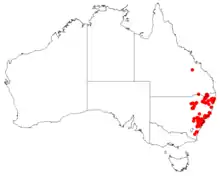Bossiaea rhombifolia
Bossiaea rhombifolia, is a species of flowering plant in the family Fabaceae and is endemic to eastern Australia. It is an erect, glabrous shrub with diamond-shaped, more or less round or broadly egg-shaped leaves, and yellow and red or pinkish flowers.
| Bossiaea rhombifolia | |
|---|---|
 | |
| In the Blue Mountains National Park | |
| Scientific classification | |
| Kingdom: | Plantae |
| Clade: | Tracheophytes |
| Clade: | Angiosperms |
| Clade: | Eudicots |
| Clade: | Rosids |
| Order: | Fabales |
| Family: | Fabaceae |
| Subfamily: | Faboideae |
| Genus: | Bossiaea |
| Species: | B. rhombifolia |
| Binomial name | |
| Bossiaea rhombifolia | |
 | |
| Occurrence data from AVH | |
| Synonyms[1] | |
| |
.jpg.webp)
Description
Bossiaea rhombifolia is an erect, more or less glabrous shrub that typically grows to a height of up to 2 m (6 ft 7 in), and has slightly flattened young stems. The leaves are diamond-shaped, more or less round or broadly egg-shaped, 4–12 mm (0.16–0.47 in) long and wide on a petiole 0.5–1.0 mm (0.020–0.039 in) long with triangular brown stipules about 1 mm (0.039 in) long at the base. The flowers are 7–12 mm (0.28–0.47 in) long on pedicels up to 5 mm (0.20 in) long with bracts 0.5–0.8 mm (0.020–0.031 in) long at the base. The five sepals are 2.7–5 mm (0.11–0.20 in) long and joined at the base forming a tube, the upper lobes 0.6–1.5 mm (0.024–0.059 in) long and 1.5–2.5 mm (0.059–0.098 in) wide, the lower lobes slightly shorter and 0.7–1.0 mm (0.028–0.039 in) wide. There are egg-shaped bracteoles 0.8–1.5 mm (0.031–0.059 in) long near the base of the pedicel. The standard petal is yellow with a red base and up to 12 mm (0.47 in) long, the wings are brownish-red and 2.5–3.0 mm (0.098–0.118 in) wide, and the keel is pinkish to dark red and 3–4 mm (0.12–0.16 in) wide. Flowering occurs from July to October and the fruit is an oblong pod 13–18 mm (0.51–0.71 in) long.[2][3][4]
Taxonomy
Bossiaea rhombifolia was first formally described in 1825 by Augustin Pyramus de Candolle in Prodromus Systematis Naturalis Regni Vegetabilis from un unpublished description by Franz Sieber.[5][6] The specific epithet (rhombifolia) means "diamond-shaped", referring to the leaves.[7]
Distribution and habitat
This species of Bossiaea grows in woodland and forest from near Stanthorpe in south-eastern Queensland to Wadbilliga National Park near Moruya in south-eastern New South Wales.[3][4]
References
- "Bossiaea rhombifolia". Australian Plant Census. Retrieved 24 August 2021.
- Wood, Betty. "Bossiaea rhombifolia". Lucid Keys. Retrieved 25 August 2021.
- "Bossiaea rhombifolia". Royal Botanic Garden Sydney. Retrieved 25 August 2021.
- Thompson, Ian R. (2012). "A revision of eastern Australian Bossiaea (Fabaceae: Bossiaeae)". Muelleria. 30 (2): 150–151. Retrieved 25 August 2021.
- "Bossiaea rhombifolia". APNI. Retrieved 25 August 2021.
- de Candolle, Augustin P. (1825). Prodromus Systematis Naturalis Regni Vegetabilis. Vol. 2. Paris. p. 117. Retrieved 25 August 2021.
- Les Robinson - Field Guide to the Native Plants of Sydney, ISBN 978-0-7318-1211-0 page 74